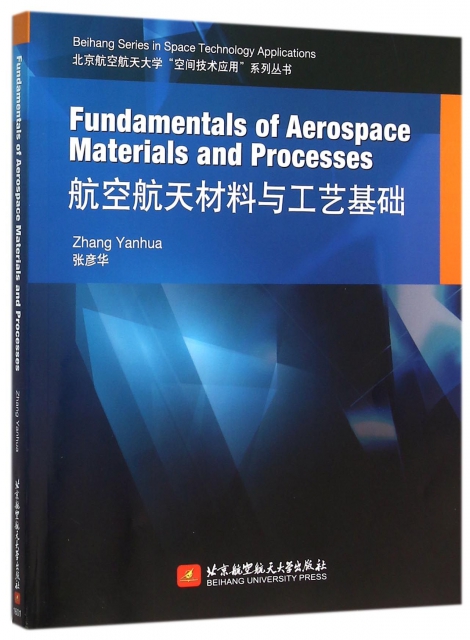| | | | 航空航天材料與工藝基礎(英文版)/北京航空航天大學空間技術應用繫列叢書 | | 該商品所屬分類:工業技術 -> 航空/航天 | | 【市場價】 | 704-1020元 | | 【優惠價】 | 440-638元 | | 【介質】 | book | | 【ISBN】 | 9787512419247 | | 【折扣說明】 | 一次購物滿999元台幣免運費+贈品
一次購物滿2000元台幣95折+免運費+贈品
一次購物滿3000元台幣92折+免運費+贈品
一次購物滿4000元台幣88折+免運費+贈品
| | 【本期贈品】 | ①優質無紡布環保袋,做工棒!②品牌簽字筆 ③品牌手帕紙巾
|
|
| 版本 | 正版全新電子版PDF檔 | | 您已选择: | 正版全新 | 溫馨提示:如果有多種選項,請先選擇再點擊加入購物車。*. 電子圖書價格是0.69折,例如了得網價格是100元,電子書pdf的價格則是69元。
*. 購買電子書不支持貨到付款,購買時選擇atm或者超商、PayPal付款。付款後1-24小時內通過郵件傳輸給您。
*. 如果收到的電子書不滿意,可以聯絡我們退款。謝謝。 | | | |
| | 內容介紹 | |

-
出版社:北京航空航天大學
-
ISBN:9787512419247
-
作者:編者:張彥華
-
頁數:329
-
出版日期:2016-01-01
-
印刷日期:2016-01-01
-
包裝:平裝
-
開本:16開
-
版次:1
-
印次:1
-
字數:476千字
-
張彥華編著的《航空航天材料與工藝基礎(英文
版)/北京航空航天大學空間技術應用繫列叢書》講述
了:The main objective in this book is to
present the fundamentals of materials
science and processes used inaerospace
engineering. The book starts with an
overview of the structures of materials
(Chapter 1). Chapter 2discusses the
mechanical properties of materials and
Chapter 3 examines the solidification and
phase diagrams.This is followed by Chapter 4
through 6 are then devoted to the important
engineering materials. The nextthree
Chapters (Chapters 7 through 9) deal with
the important field of materials processes,
namely casting,deformation forming and
welding. Chapter 10 represents the materials
and processes selection for
aerospacestructures.
The book is intended for the engineer or
student who wants to learn more about the
materials and processes used in aerospace
structure. It would be useful to designers,
structural engineers, material and
processesengineers and manufacturing
engineers involved with advanced materials.
-
Introduction
0.1 Evolution of aerospace materials
0.2 Engineering materials and process
0.3 The materials process for aerospace structures
Chapter 1 Structure of Materials
1.1 Introduction
1.2 Atomic structure
1.3 Atomic bonding
1.3.1 Ionic bonding
1.3.2 Covalent bonding
1.3.3 Metallic bonding
1.3.4 Van der Waals bonding
1.4 Crystal structure of metals
1.4.1 Atomic arrangements in materials
1.4.2 Metallic crystalline structures
1.5 Crystal defects
1.5.1 Point defects
1.5.2 Linear defects--dislocations
1.5.3 Planar defects
1.5.4 Bulk defects
1.6 Alloys and microstrueture
1.6.1 Alloying
1.6.2 Phases
1.6.3 Microstrueture
Chapter 2 Mechanical Properties of Materials
2.1 Introduction
2.2 Tensile properties
2.2.1 Stress and strain
2.2.2 The tensile test
2.2.3 Yield point
2.2.4 Ultimate tensile strength
2.3 Ductility and strain hardening
2.3.1 Ductility
2.3.2 Strain hardening
2.4 Hardness
2.4.1 Brinell hardness test
2.4.2 Rockwell hardness test
2.4.3 Vickers and Knoop hardness tests
2.5 Creep and stress rupture properties
2.5.1 Creep properties
2.5.2 Stress rupture properties
2.6 Toughness
2.6.1 Impact toughness
2.6.2 Fracture toughness
2.7 Fatigue properties
2.7.1 Nature of fatigue failure
2.7.2 Factors affecting fatigue life
2.7.3 S-N fatigue properties
2.7.4 Fatigue crack growth rate
Chapter 3 Solidification and Phase Diagrams
3.1 Introduction
3.2 Phase diagram
3.2.1 Common terms
3.2.2 Isomorphous
3.2.3 Eutectic
3.2.4 Peritectic reaction
3.2.5 Eutectoid
3.3 Fe-C phase diagram and microstructure
3.3.1 Fe-C phase diagram
3.3.2 Fe-C alloys microstructure
Chapter 4 Ferrous Alloys
4.1 Introduction
4.2 Classification of ferrous alloys
4.3 Alloy steels
4.3.1 Alloying elements in steel
4.3.2 High-Strength Low-Alloy (HSLA) steels
4.3.3 High-alloy steels
4.3.4 Stainless steels
4.3.5 Tool steels
4.3.6 Ultra-high strength steels
4.4 Heat treatments
4.4.1 Transformation diagrams
4.4.2 Types of heat treatment
4.5 Surface hardening
4.5.1 Surface quenching
4.5.2 Carburizing and nitriding
Chapter 5 Non-ferrous Alloys
5.1 Introduction
5.2 Aluminum and aluminum alloys
5.2.1 Physical metallurgy of aluminum
5.2.2 Aluminum alloy designations
5.3 Copper and its alloys
5.4 Magnesium alloys
5.5 Titanium and its alloys
5.5.1 Development and application of titanium alloys
5.5.2 Metallurgy of titanium alloys
5.6 Superalloys
5.6.1 Nickel and nickel alloys
5.6.2 Cobalt-based superalloys
5.6.3 Iron-based superalloys
Chapter 6 Polymer, Ceramic and Composite Materials
6.1 Introduction
6.2 Polymer
6.2.1 Polymer structure and synthesis
6.2.2 Polymer crystallinity
6.2.3 Mechanical behavior of polymers
6.2.4 Characteristics and typical applications of few plastic materials
6.3 Ceramics
6.3.1 Structures of ceramic materials
6.3.2 Ceramic processing
6.3.3 General properties of ceramics
6.3.4 Common structural ceramics
6.4 Composite
6.4.1 Composite structure
6.4.2 General types of matrix materials
6.4.3 Reinforcements
Chapter 7 Casting Processes
7.1 Introduction
7.2 Sand casting
7.3 Investment casting
7.4 Die casting
7.5 Permanent mold casting
7.6 Centrifugal casting
7.7 Casting techniques for single-crystal components
7.8 Casting microstructure and defects
Chapter 8 Deformation Forming Processes
8.1 Introduction
8.2 Plastic deformation and formability
8.3 Bulk deformation processes
8.3.1 Forging processes
8.3.2 Extrusion and drawing processes
8.3.3 Rolling processes
8.4 Sheet metal forming
8.4.1 Blanking and piercing
8.4.2 Bending
8.4.3 Stamping or deep drawing
8.4.4 Stretch forming
8.4.5 Hydroforming
8.4.6 Metal spinning
Chapter 9 Welding Processes
9.1 Introduction
9.2 Fusion welding
9.2.1 Arc welding
9.2.2 Energy beam welding
9.2.3 Resistance welding
9.3 Solid-state welding
9.3.1 Friction welding
9.3.2 Diffusion bonding
9.3.3 Explosion welding
9.3.4 Ultrasonic welding
9.4 Brazing and soldering
9.5 Welded joints design
9.5.1 Joints and weld
9.5.2 Welding position
9.6 Welding quality
9.6.1 Residual stresses and distortion
9.6.2 Weld defects
9.6.3 Destructive testing of welds
Chapter 10 Materials Selection for Aerospace Structural Application
10.1 Introduction
10.2 Aircraft structures and materials
10.2.1 Aircraft structures
10.2.2 Aircraft materials
10.3 Aero engine materials
10.3.1 Traditional engine materials
10.3.2 Advanced materials
10.4 Space material
10.4.1 Space environment
10.4.2 Launch vehicles
10.4.3 Spacecraft
10.4.4 Satellite structure and materials
10.4.5 Space station materials and processes
10.4.6 Space materials processing
References
| | |
| | | | |
|




